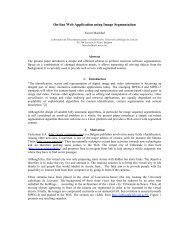motion estimation and compensation for very low bitrate video coding
motion estimation and compensation for very low bitrate video coding
motion estimation and compensation for very low bitrate video coding
You also want an ePaper? Increase the reach of your titles
YUMPU automatically turns print PDFs into web optimized ePapers that Google loves.
Chapter 2<br />
Motion in the Framework<br />
of Video Coding<br />
The extraction of <strong>motion</strong> in<strong>for</strong>mation from a sequence of time-varying<br />
images has numerous applications in the eld of image processing: medical<br />
image analysis, mobile robot navigation, automatic tracking of moving<br />
objects, interpretation of atmosphere observation (remote sensing),<br />
image interpolation <strong>and</strong> restoration,... as well as digital <strong>video</strong> compression.<br />
As seen in the introduction to (VLBR) <strong>video</strong> <strong>coding</strong> (cf. Chapter<br />
1), <strong>motion</strong> <strong>estimation</strong> & <strong>compensation</strong> plays a key role in <strong>video</strong><br />
compression as it results in the most per<strong>for</strong>ming compression gains.<br />
This chapter does not claim to propose a complete overview of all existing<br />
<strong>motion</strong> <strong>estimation</strong> techniques in the <strong>video</strong> <strong>coding</strong> context. This<br />
task has already been successfully achieved with numerous results <strong>and</strong><br />
comments in specialized books like [127] or articles like [108, 31], in<br />
which extensive references are given. Yet, it seems important to review<br />
the most classical techniques in order to present the state of the art <strong>and</strong><br />
to highlight the contribution put <strong>for</strong>ward by the present work.<br />
Another aim is to emphasize the distinction between the <strong>estimation</strong> <strong>and</strong><br />
the <strong>compensation</strong> stages of a codec. Figure 2.1 brie y reminds one<br />
that <strong>estimation</strong> is per<strong>for</strong>med at the encoder side in order to extract the<br />
<strong>motion</strong> parameters of the <strong>video</strong> sequence, while the decoder uses the<br />
estimated <strong>motion</strong> in<strong>for</strong>mation during the <strong>compensation</strong> phase. A parallel<br />
can be established between the general principles of <strong>video</strong> compression<br />
(cf. Section 1.2) <strong>and</strong> <strong>motion</strong> <strong>estimation</strong> & <strong>compensation</strong> processes,<br />
which are based on three main steps:





